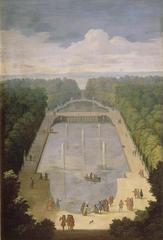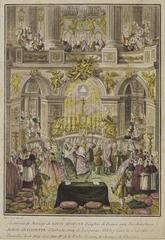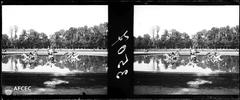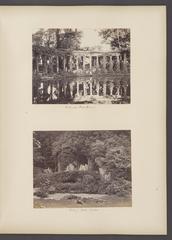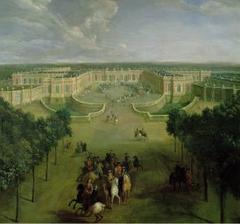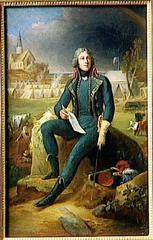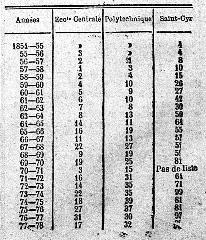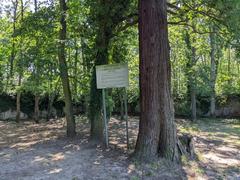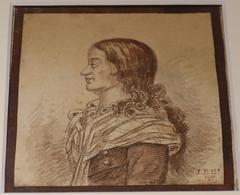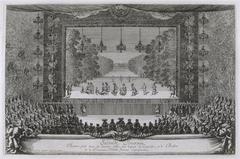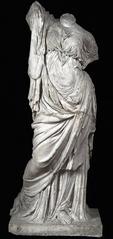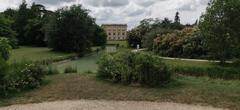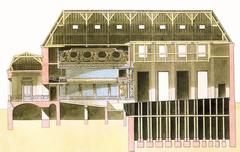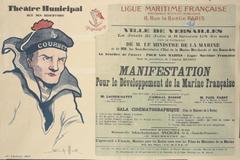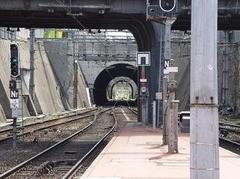Comprehensive Guide to Visiting Route des Sources de la Bièvre, Versailles, France
Date: 19/07/2024
Introduction
The Route des Sources de la Bièvre in Versailles, France, offers an intriguing blend of history, culture, and natural beauty. Tracing its origins back to the early medieval period, this scenic pathway follows the Bièvre River, a vital water source since ancient times. The name ‘Bièvre’ is derived from the Latin word ‘biber,’ meaning beaver, indicating the historical presence of these animals in the region (Versailles Tourism). Over centuries, the route has played a significant role in the development of Versailles, particularly during the Renaissance when the Château de Versailles was constructed. The water from the Bièvre River was ingeniously channeled to supply the palace’s elaborate fountains and gardens. The route also witnessed pivotal events during the French Revolution and underwent significant industrialization in the 19th century, which unfortunately led to environmental degradation (Versailles Tourism). In recent years, extensive restoration and conservation efforts have transformed the Route des Sources de la Bièvre into a popular tourist destination. Visitors can now explore its rich tapestry of historical landmarks, picturesque landscapes, and diverse ecosystems through scenic walks, guided tours, and various cultural events. Whether you are a history enthusiast, nature lover, or simply looking for a peaceful escape, the Route des Sources de la Bièvre promises a memorable and enriching experience.
Table of Contents
- Introduction
- History of Route des Sources de la Bièvre
- Visitor Information
- Cultural Significance
- Architectural Marvels
- Ecological Importance
- Modern-Day Attractions
- Visitor Tips
- FAQ
- Conclusion
History of Route des Sources de la Bièvre
Origins and Early History
The Bièvre River, from which the route derives its name, has been a significant water source since ancient times. The name “Bièvre” is derived from the Latin word “biber,” meaning beaver, indicating the presence of these animals in the area during Roman times. The river played a crucial role in the development of the region, providing water for agriculture and supporting local wildlife.
Development During the Renaissance
During the Renaissance, the Route des Sources de la Bièvre gained prominence due to the increasing importance of Versailles as a political and cultural center. The construction of the Château de Versailles in the 17th century by King Louis XIV marked a turning point in the history of the route. The Bièvre River was harnessed to supply water to the elaborate fountains and gardens of the palace, showcasing the engineering prowess of the time. The route became a vital link between the sources of the river and the palace, facilitating the transportation of water and other resources.
The Role in the French Revolution
The Route des Sources de la Bièvre also played a significant role during the French Revolution. As Versailles became a focal point of revolutionary activity, the route served as a pathway for the movement of troops and supplies. The Bièvre River, with its strategic importance, was closely monitored and controlled by revolutionary forces. The route witnessed numerous skirmishes and conflicts, reflecting the turbulent nature of the period.
Industrialization and Modernization
The 19th century brought about significant changes to the Route des Sources de la Bièvre with the advent of industrialization. The river, once a pristine water source, became heavily polluted due to the rapid growth of industries along its banks. Factories and tanneries discharged waste into the river, leading to severe environmental degradation. Efforts to clean and restore the Bièvre River began in the late 20th century, with initiatives aimed at preserving its historical significance and ecological balance.
Restoration and Conservation Efforts
In recent years, the Route des Sources de la Bièvre has undergone extensive restoration and conservation efforts. The French government, along with local authorities and environmental organizations, has implemented measures to rehabilitate the river and its surroundings. These efforts include the removal of pollutants, reforestation of the riverbanks, and the creation of protected areas to preserve the natural habitat. The route has been transformed into a scenic pathway, attracting tourists and nature enthusiasts.
Visitor Information
Visiting Hours
The Route des Sources de la Bièvre is open to visitors year-round. However, specific sections may have restricted access during certain seasons for conservation purposes. It is recommended to check the official Versailles Tourism website for the latest visiting hours.
Tickets and Accessibility
Access to the Route des Sources de la Bièvre is generally free of charge. However, guided tours and special events may require tickets, which can be purchased online or at designated ticket counters. The pathway is accessible to visitors with mobility impairments, with several sections equipped with ramps and handrails.
Cultural Significance
The Route des Sources de la Bièvre holds immense cultural significance, reflecting the rich history and heritage of Versailles. The route is dotted with historical landmarks, including ancient mills, bridges, and remnants of medieval settlements. These sites offer a glimpse into the past, allowing visitors to connect with the region’s history. The route also hosts various cultural events and festivals, celebrating the traditions and customs of the local communities.
Architectural Marvels
One of the highlights of the Route des Sources de la Bièvre is the architectural marvels that line its path. The Château de Versailles, a UNESCO World Heritage site, stands as a testament to the grandeur of French architecture. The palace, with its opulent interiors and meticulously designed gardens, attracts millions of visitors each year. The route also features other notable structures, such as the Grand Trianon and the Petit Trianon, which served as retreats for French royalty.
Ecological Importance
The Bièvre River and its surrounding ecosystem hold significant ecological importance. The river supports a diverse range of flora and fauna, including several endangered species. Conservation efforts have focused on preserving the natural habitat and promoting biodiversity. The route offers opportunities for nature walks, birdwatching, and educational programs, allowing visitors to appreciate the ecological richness of the area.
Modern-Day Attractions
Today, the Route des Sources de la Bièvre is a popular tourist destination, offering a blend of historical, cultural, and natural attractions. Visitors can explore the picturesque landscapes, visit historical landmarks, and engage in recreational activities such as hiking and cycling. The route also features charming villages and local markets, providing a glimpse into the traditional way of life in the region.
Visitor Tips
Best Time to Visit
The Route des Sources de la Bièvre is best visited during the spring (April to June) and autumn (September to November) months. During these periods, the weather is mild, and the natural surroundings are at their most vibrant. Summer can be quite crowded due to the influx of tourists, while winter might be less appealing due to colder temperatures and shorter daylight hours.
Getting There
Versailles is well-connected by public transportation. The most convenient way to reach the Route des Sources de la Bièvre is by taking the RER C train from Paris to Versailles Château Rive Gauche station. From there, local buses or taxis can take you closer to the starting point of the route. For those driving, there are parking facilities available near the trailhead.
What to Wear
Comfortable walking shoes are essential as the route involves a fair amount of walking through natural terrain. Depending on the season, layered clothing is advisable. In spring and autumn, a light jacket or sweater is recommended, while in summer, breathable fabrics and sun protection (hat, sunglasses, sunscreen) are necessary. In winter, ensure you have warm clothing, including gloves and a scarf.
Essential Items to Bring
- Water and Snacks: There are limited facilities along the route, so carrying sufficient water and snacks is crucial.
- Map or GPS Device: While the route is marked, having a map or GPS device can help ensure you stay on track.
- Camera: The scenic beauty of the route offers numerous photo opportunities.
- First Aid Kit: A basic first aid kit can be handy for minor injuries or ailments.
- Insect Repellent: Particularly in the warmer months, insect repellent can help protect against bites.
Accessibility
The Route des Sources de la Bièvre is moderately accessible. While the path is generally well-maintained, it may not be suitable for those with mobility issues due to uneven terrain and occasional steep sections. Families with young children should be prepared for some challenging parts of the trail.
Guided Tours
For those interested in a more informative experience, guided tours are available. These tours often provide historical and ecological insights that enhance the visit. Booking in advance is recommended, especially during peak tourist seasons. Information on guided tours can be found on the Versailles Tourism website.
Points of Interest Along the Route
- Bièvre River: The route follows the Bièvre River, offering picturesque views and opportunities to learn about the river’s historical significance.
- Historical Markers: Various markers along the route provide information about the history and significance of the area.
- Flora and Fauna: The route is rich in biodiversity, with numerous species of plants and animals to observe. Birdwatchers, in particular, will find the area rewarding.
Safety Tips
- Stay on Marked Paths: To protect the environment and ensure your safety, always stay on the marked paths.
- Weather Awareness: Check the weather forecast before your visit and be prepared for sudden changes in weather conditions.
- Emergency Contacts: Have local emergency contact numbers saved on your phone. In France, the general emergency number is 112.
Local Etiquette
- Respect Nature: Do not pick plants or disturb wildlife. Carry out all trash to keep the area pristine.
- Quiet Enjoyment: Maintain a respectful noise level to preserve the tranquility of the natural surroundings and for the enjoyment of other visitors.
- Cultural Respect: Be mindful of any cultural or historical sites along the route, treating them with the respect they deserve.
Nearby Amenities
- Restaurants and Cafes: There are several dining options in Versailles where you can enjoy a meal before or after your visit. For a list of recommended places, visit TripAdvisor.
- Accommodation: If you plan to stay overnight, Versailles offers a range of accommodations from budget hotels to luxury stays. Booking in advance is advisable, especially during peak seasons.
Photography Tips
- Golden Hour: The best times for photography are during the golden hours—shortly after sunrise and before sunset—when the light is soft and warm.
- Nature Shots: Use a macro lens for close-up shots of flora and fauna. A wide-angle lens is ideal for capturing the expansive landscapes.
- Respect Privacy: If photographing other visitors, always ask for permission to respect their privacy.
Environmental Responsibility
- Leave No Trace: Follow the principles of Leave No Trace to minimize your impact on the environment.
- Sustainable Travel: Consider using public transportation or carpooling to reduce your carbon footprint. For more tips on sustainable travel, visit Sustainable Travel International.
FAQ
What are the visiting hours for Route des Sources de la Bièvre?
The Route des Sources de la Bièvre is open daily from 8:00 AM to 6:00 PM.
Are there guided tours available?
Yes, guided tours are available and provide detailed information about the historical and ecological significance of the Bièvre River. Fees may apply.
How much do tickets cost?
Access to the route is generally free, but guided tours and special events may require tickets. Prices vary depending on the event.
Is the route accessible to people with disabilities?
Yes, several sections of the route are equipped with ramps and handrails to accommodate visitors with mobility impairments.
What is the best time to visit?
The best time to visit is during the spring and summer months, but each season offers a unique experience.
Conclusion
The Route des Sources de la Bièvre in Versailles offers a unique journey through time and nature. From its early medieval origins to its vital role during the Renaissance and the French Revolution, the route encapsulates the rich history and cultural significance of the region. Today, extensive restoration efforts have revived its natural beauty, making it a haven for tourists and nature enthusiasts alike. Visitors can enjoy guided tours, scenic walks, and a variety of cultural events, all while appreciating the ecological importance of the Bièvre River and its surroundings. With no entry fee and accessibility options for all, the Route des Sources de la Bièvre is an inviting destination that promises a blend of historical intrigue and natural splendor. For more detailed information and updates, consider following the official Versailles Tourist Office website or downloading the Audiala mobile app.
References
- Exploring the Route des Sources de la Bièvre - History, Visiting Hours, and Travel Tips. (2023) Versailles Tourism
- Exploring the Route des Sources de la Bièvre - History, Visitor Tips, and Cultural Significance. (2023) Versailles Tourism
- Essential Visitor Tips for Exploring Route des Sources de la Bièvre in Versailles. (2023) Versailles Tourism
